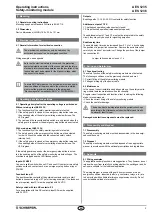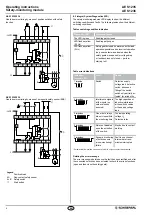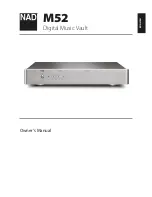
3
AES 1235
AES 1236
Operating instructions
Safety-monitoring module
EN
3. Mounting
3.1 General mounting instructions
Mounting: snaps onto standard DIN rails to EN 60715.
3.2 Dimensions
Device dimensions (H/W/D): 100 x 22.5 x 121 mm
4. Electrical connection
4.1 General information for electrical connection
The electrical connection may only be carried out by
authorised personnel in a de-energised condition.
Wiring examples: see appendix
As far as the electrical safety is concerned, the protection
against unintentional contact of the connected and therefore
electrically interconnected apparatus and the insulation of the
feed cables must be designed for the highest voltage, which
can occur in the device.
To avoid EMC disturbances, the physical ambient and opera-
tional conditions at the place where the product is installed,
must meet the provisions laid down in the paragraph
"Electromagnetic Compatibility (EMC)" of DIN EN 60204-1.
5. Operating principle and settings
5.1 Operating principle after the operating voltage is switched on
Without start-up test AES 1235:
1. The functionality of the safety-monitoring module is tested.
2. If the safety guard is closed or the emergency stop button released,
the enabling paths of the safety-monitoring module will close. The
LED is green.
3. The cable and the connected safety switch are only tested when the
safety guard is opened or the emergency stop button when actuated
With start-up test AES 1236:
1. The functionality of the safety-monitoring module is tested.
2. The safety guard or the emergency stop button must be actuated,
in order to check the cables and the connected safety switch
(start-up test).
3. If the safety guard is closed or the emergency stop button released,
the enabling paths of the safety-monitoring module will close. The
LED is green.
If the safety guard is opened or the emergency-stop button is actua-
ted, the enabling paths of the safety-monitoring module will open. The
machine is stopped and the LED flashes yellow.
Inputs: S14/S22
Connect a safety switch with one NC and one NO contact or two safety
switches with one contact each or an emergency-stop button at input
S14/S22.
Feedback loop: X1
The positive action contacts of the external contactor and/or a start
button is connected to input X1 (refer to wiring example). If no feedback
loop is required, input X1 must be supplied with 24 VDC.
Safety switch with two NC contacts: X2
For an operation with two NC contacts, input X2 must be supplied
with 24 VDC.
Outputs
Enabling paths 13-14, 23-24: NO contacts for safety function
Additional outputs Y1/Y2:
Y1: Authorized operation (release output closed)
Y2: No authorized operation (release output opened)
The additional outputs Y1 and Y2 must not be integrated in the safety
circuit; they may only be used for signalling purposes.
Enable delay time
The enable delay time can be increased from 0.1 s to 1 s by changing
the position of a jumper link connection. Remove the enclosure cover
carefully by means of a screwdriver. Change the position of the jumper
link connection B1.
Jumper link connection closed = 1 s
6. Set-up and maintenance
6.1 Functional testing
The safety function of the safety-monitoring module must be tested.
The following conditions must be previously checked and met:
1. Correct fitting of the safety-monitoring module
2. Fitting and integrity of the power cable
6.2 Maintenance
In the case of correct installation and adequate use, the safety-monito-
ring module features maintenance-free functionality.
A regular visual inspection and functional test, including the following
steps, is recommended:
• Check the correct fixing of the safety monitoring module
• Check the cable for damage.
The device has to be integrated into the periodic check-ups
according to the Ordinance on Industrial Safety and Health,
however at least 1x/year.
Damaged or defective components must be replaced.
7. Disassembly and disposal
7.1 Disassembly
The safety monitoring module must be disassembled in the de-energi-
sed condition only.
7.2 Disposal
The safety monitoring module must be disposed of in an appropriate
manner in accordance with the national prescriptions and legislations.
8. Appendix
8.1 Wiring examples
The application examples shown are suggestions. They however do not
release the user from carefully checking whether the switchgear and its
set-up are suitable for the individual application.
The wiring diagram is shown with guard doors closed and in a de-
energised condition. Inductive loads (e.g. contactors, relays, etc.) are
to be provided with suitable interference suppression circuitry. Do not
connect additional loads to terminal S..
























